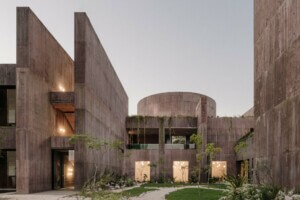For the Chicago Architecture Biennial opening on September 19, SOM debuted a concrete pavilion called Stereoform Slab to showcase the latest in material and manufacturing technology.
As much as 60 percent of a building’s carbon footprint can result from the creation of concrete slabs, according to SOM. By developing new fabrication methods and integrating robotic construction, the firm reported that a 20 percent reduction in material use and waste equaled an equal reduction in carbon output. The fluid form of Stereoform Slab, designed as a full-scale abstraction of the single-story concrete bays you might find in a high-rise, was built in partnership with McHugh Construction, the developer Sterling Bay, Denmark-based Odico Construction Robotics, and Autodesk.

Using robots, Odico fabricated EPS foam molds which were shipped from Odense, Denmark, to the U.S. “The shape is formed of a specific, but simple class of geometry—the ruled surface,” the interdisciplinary research team behind the project at SOM said in an email. “This formal constraint is derived from the nature of the fabrication method itself, a hot-wire spanning an eight feet width at the end of a seven-axis robotic arm.” While one might have seen this “constraint” as just that, a restriction, the designers said they saw it as a way of offering “geometric freedom,” and also enjoyed the high fabrication speed.
While new technology has allowed for designers to conceive of “more sustainable and expressive structures,” the resulting complexity often makes them hard to realize with conventional construction techniques. “The impetus for Stereoform Slab, however, was to prove that emerging approaches to fabrication using advanced robotics could help close this gap, and that this type of formwork could augment more conventional concrete forming systems without adding additional cost to construction,” the SOM team explained.

Odico used a proprietary technology called robotic abrasive wire cutting, which allows for the rapid creation of polystyrene formworks—reportedly at up to 126 times the speed of traditional methods. “Because of this advantage, formworks can be produced at very low cost compared to conventional timber formwork molds,” said Asbjørn Søndergaard, chief technology officer of Odico, “which is the critical enabler for realizing more advanced, structural designs that save material through more intelligent use of material.”
SOM isn’t doing away with the human hand entirely, and they said that “This type of advanced fabrication is about augmenting human labor in order to expand design freedom and the potential to actually build what we can imagine and create with more advanced digital design methodologies”
Though certainly smaller than a tower, working closely with the robotic manufacturers and with a firm, McHugh Construction, that focuses on high rises means that the Stereoform Slab has more in common with a construction prototype than a pavilion.
The Stereoform Slab will be up until January 5th, along with a bench produced by the same process at the Chicago Athletic Association.











